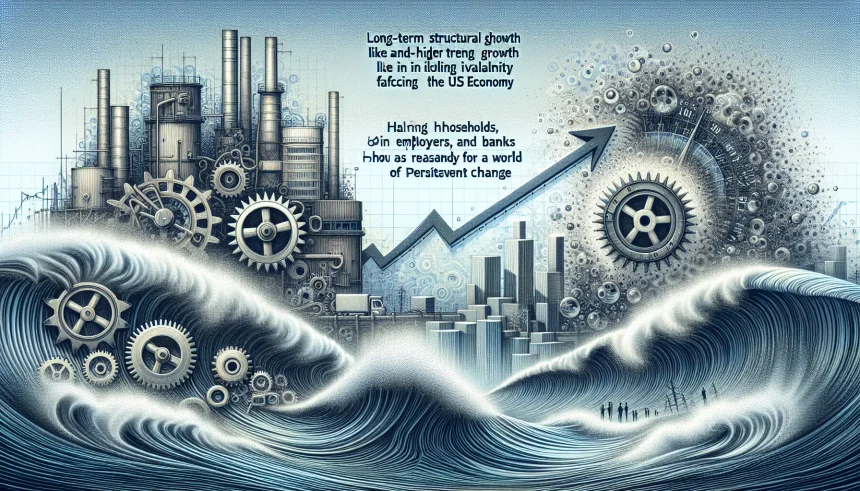A senior U.S. financial regulator, Kevin Stiroh, warned that the nation is entering a period shaped by long-term, structural shocks that could challenge growth, prices, and financial stability. His message lands as policymakers weigh how to manage inflation risks, strained budgets, and uneven productivity. The stakes are broad: households, employers, and banks must plan for a world in which change is persistent rather than brief.
“The US economy faces a series of long-term, structural shocks,” Stiroh said.
Stiroh, who has served in top supervisory roles at the Federal Reserve, pointed to forces that are hard to reverse. These include an aging workforce, supply chain realignments, climate-related risks, and rapid advances in technology. Each force can reshape investment decisions, push prices, or alter job markets in ways that last for years.
Demographics and the labor force
America is getting older, and the labor force is growing more slowly than in past decades. A smaller share of prime-age workers can limit potential output and tighten job markets even without strong demand. That can mean higher wage pressures in some sectors and pressure on firms to automate or reskill workers.
Economists have long linked demographics to trend growth. With fewer new workers, productivity must do more of the heavy lifting. That makes policies around training, childcare access, and skilled immigration especially important, because they can lift participation and ease hiring gaps.
Debt, interest costs, and fiscal pressures
Rising public debt and higher interest rates raise borrowing costs for the government, businesses, and consumers. The Congressional Budget Office projects that federal interest payments will take a larger share of tax revenue over the next decade. That leaves less room for public investment and safety-net programs during downturns.
For firms, higher rates can slow capital spending and weigh on valuations. For households, mortgages, car loans, and credit card balances become harder to carry. Persistent fiscal pressure can also add uncertainty to markets, feeding bouts of volatility.
Supply chains, geopolitics, and price pressures
Global trade patterns are shifting as companies diversify suppliers and reduce exposure to single regions. This can build resilience, but it often adds cost in the short run. Stiroh’s warning suggests that such shifts are not a passing phase, but a feature of planning for large manufacturers and retailers alike.
Prices for key inputs—from semiconductors to critical minerals—may remain more volatile under this model. Firms that invest in redundancy, inventory buffers, and regional networks could fare better, but those steps take time and money.
Climate risk and financial stability
Physical risks, such as extreme weather, and transition risks, such as changing energy policy and technology, can hit balance sheets. Banks and insurers face rising modeling challenges as historical data offer less guidance for future losses. Communities exposed to floods, heat, or wildfire risk may see property values and tax bases shift.
Supervisors have pressed financial institutions to improve risk management, scenario analysis, and disclosures. The goal is not to pick winners, but to ensure firms can measure and manage exposures that could emerge suddenly.
Technology, AI, and the productivity question
Artificial intelligence and automation could lift productivity, but the timing and scale remain uncertain. If gains arrive slowly, the economy could face higher costs without enough efficiency to offset them. If gains arrive fast, workers may need rapid reskilling to avoid dislocation.
Experts highlight a few near-term steps that can help:
- Invest in worker training tied to specific tasks and tools.
- Upgrade cybersecurity as digital adoption expands.
- Measure outcomes to ensure technology spending delivers returns.
What this means for households, businesses, and policy
Households may see more frequent price swings in essentials like energy and food. Businesses could face tighter margins if costs stay elevated, pushing them to automate or reorganize supply chains. Policymakers will need to balance inflation control with growth, while keeping an eye on pockets of financial stress.
The common thread in Stiroh’s message is persistence. These forces play out over years, not quarters. That calls for steady planning, better data, and strong risk controls at banks and nonbanks alike.
Stiroh’s warning is not a forecast of crisis but a call for preparation. Demographics, debt, supply chain shifts, climate risk, and fast-moving technology are reshaping the baseline. The next phase will reward firms and communities that plan for uncertainty, invest in people, and monitor risk closely. Watch for signals in productivity data, labor participation, and credit conditions—they will show whether resilience is building or new pressures are forming.







